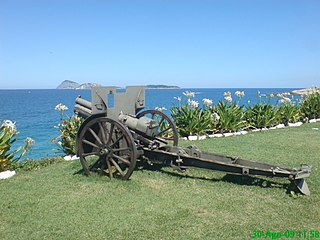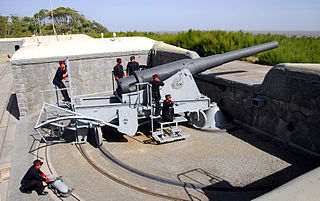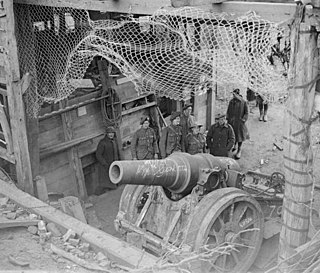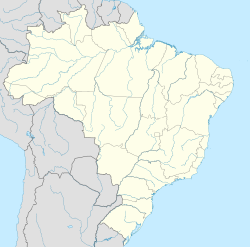
Copacabana is a bairro (neighbourhood) located in the South Zone of the city of Rio de Janeiro, Brazil. It is most prominently known for its 4 km (2.5 miles) balneario beach, which is one of the most famous in the world.

The Canon de 75 M (montagne) modèle 1919 Schneider was a French mountain gun designed as a replacement of the 65 mm mle 1906. The mle 1919 was manufactured by Schneider et Cie and used during World War II. For transport, the gun could be broken down into seven sections. This weapon was used by Brazil, Paraguay, Yugoslavia and Greece. When captured by the Germans in World War II, the French guns were designated 7.5 cm GebK 237(f); the Yugoslav guns were designated 7.5 cm GebK 283(j). The gun crew was protected by an armoured shield.

The Renault FT is a French light tank that was among the most revolutionary and influential tank designs in history. The FT was the first production tank to have its armament within a fully rotating turret. The Renault FT's configuration became and remains the standard tank layout. Consequently, some armoured warfare historians have called the Renault FT the world's first modern tank.

The 8.8 cm Flak 18/36/37/41 is a German 88 mm anti-aircraft and anti-tank artillery gun, developed in the 1930s. It was widely used by Germany throughout World War II and is one of the most recognized German weapons of the conflict. The gun was universally known as the Acht-acht ("eight-eight") by the Germans and the "eighty-eight" by the Allies. Due to its lethality, especially as a tank killer, the eighty-eight was greatly feared by Allied soldiers.

The 40.6 cm SK C/34, sometimes known as the Adolfkanone, was a German naval gun, designed in 1934 by Krupp and originally intended for the early H-class battleships.

A railway gun, also called a railroad gun, is a large artillery piece, often surplus naval artillery, mounted on, transported by, and fired from a specially designed railway wagon. Many countries have built railway guns, but the best-known are the large Krupp-built pieces used by Germany in World War I and World War II. Smaller guns were often part of an armoured train. They were only able to be moved where there were good tracks, which could be destroyed by artillery bombardment or airstrike. Railway guns were phased out after World War II.

Coastal artillery is the branch of the armed forces concerned with operating anti-ship artillery or fixed gun batteries in coastal fortifications.

The Hotchkiss gun can refer to different types of the Hotchkiss arms company starting in the late 19th century. It usually refers to the 1.65-inch (42 mm) light mountain gun; there were also a navy (47 mm) and a 3-inch (76 mm) Hotchkiss guns. The 42 mm gun was intended to be mounted on a light carriage or packed on two mules to accompany a troop of cavalry or an army travelling in rough country.

The Mk44 Bushmaster II is a 30 mm chain gun manufactured by Northrop Grumman. It is a derivative of the 25 mm M242 Bushmaster, and uses 70% of the same parts as the M242 while increasing the firepower by as much as 50% with the 20% increase in caliber size. The barrel is chromium-plated for extended life. The gun uses standard GAU-8 Avenger ammunition that is available in API, HEI and APFSDS-T variants.

São Paulo was a dreadnought battleship of the Brazilian Navy. It was the second of two ships in the Minas Geraes class, and was named after the state and city of São Paulo.

The Canon de 155 Grande Puissance Filloux (GPF) modèle 1917 was a WWI-era French-designed 155 mm gun used by the French Army and the United States Army during the first half of the 20th century in towed and self-propelled mountings.

The Copacabana Fort revolt, also known as the 18 of the Fort revolt, was one of several movements coordinated by rebel factions of the Brazilian Army against the president of Brazil, Epitácio Pessoa, and the winner of the 1922 presidential election, Artur Bernardes. Acting under the figure of marshal Hermes da Fonseca and supporting the defeated faction, the Republican Reaction, the rebels tried a wide revolt in Rio de Janeiro on 5 July 1922, but only managed to control Fort Copacabana and the Military School of Realengo, in addition to, outside the city, a focus in Niterói and the 1st Military Circumscription, in Mato Grosso. They were defeated, but the revolt marks the beginning of tenentism and the events that led to the end of the First Brazilian Republic.

Minas Geraes, spelled Minas Gerais in some sources, was a dreadnought battleship of the Brazilian Navy. Named in honor of the state of Minas Gerais, the ship was laid down in April 1907 as the lead ship of its class, making the country the third to have a dreadnought under construction and igniting a naval arms race between Brazil, Argentina, and Chile.

The Armed Forces of the Empire of Brazil were the overall unified military forces of the Empire of Brazil. The Brazilian military was first formed by Emperor Dom Pedro I to defend the new nation against the Portuguese in the Brazilian War of Independence. The Army and Armada were commissioned in 1822 with the objective of defeating and expelling the Portuguese troops from Brazilian soil.

Two Minas Geraes-class battleships were built for the Brazilian Navy in the early twentieth century. Named Minas Geraes and São Paulo, these "dreadnought" warships were intended to be Brazil's first step towards becoming an international power, and they consequently initiated a South American naval arms race.

Avenida Atlântica is a major seaside avenue in Rio de Janeiro, Brazil. It is 4 kilometres (2.5 mi) long, and spans the entire length of the neighbourhoods of Copacabana and Leme.

São Marcelo Fort, also known as Forte de Nossa Senhora do Pópulo e São Marcelo or Forte do Mar, is located in Salvador in Bahia, Brazil. It is located in small bit of land off the coast in the Baía de Todos os Santos. Standing on a small bank of reefs about 300 metres (980 ft) from the coast, it is one of two forts separated by water from land in Brazil, the other being the Fort Tamandaré da Laje Tamandaré in Rio de Janeiro. It is the only cylindrical fort in Brazil. Its design follows those of Castel Sant'Angelo in Italy and São Lourenço do Bugio Fort in Portugal. It is popularly known as the "Forte do Mar". It was built to protect the important port city Salvador from threats; the city had the largest number of forts during the colonial period of Brazil.

The Passage of Humaitá was an operation of riverine warfare during the Paraguayan War − the most lethal in South American history − in which a force of six Imperial Brazilian Navy armoured vessels was ordered to dash past under the guns of the Paraguayan fortress of Humaitá. Some competent neutral observers had considered that the feat was very nearly impossible.

The 24 cm K L/35 was a German naval gun developed in the years before World War I that armed ships of the Imperial German Navy, Argentine Navy and the Austro-Hungarian Navy. Guns removed from ships of the Imperial German Navy were modified to perform Coastal Artillery and Railway Artillery roles and saw service in both world wars.

The 21 cm Haubitze M1891 or (21 cm Howitzer Model 1891) in English was a fortress gun built by Krupp that armed the forts of several European countries before World War I. Two countries that bought the M1891 were Belgium and Romania. In Belgian service it was designated Obusier de 21c.A. and in Romanian service it was designated Obuzierul Krupp, calibrul 210 mm, model 1891.




























